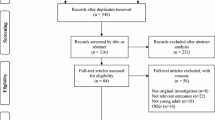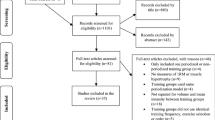Abstract
The aim of this study was to test the hypothesis that low intensity exercise-induced low frequency fatigue is caused by failure of excitation-contraction coupling. Changes in knee extension torque at 5, 10, 15, 20 and 50 Hz electrical stimulation of quadriceps muscle in ten healthy, young, male subjects were recorded during 20-min voluntary exercise followed by 60-min recovery. In seven of the ten subjects, changes in torque during 3 min of 10-Hz stimulation were recorded 2 min and 20 min after 20 min voluntary exercise. Exercise was performed at 30% of maximal voluntary contraction with a contraction plus relaxation period of 6 plus 4 s. Torque at 5, 10, 15, 20 and 50-Hz stimulation at the end of exercise was reduced to mean 91.0 (SEM 5.4)%, 68.7 (SEM 5.4)%, 67.2 (SEM 3.9)%, 66.5 (SEM 4.5)% and 74.7 (SEM 4.3)% of control values, respectively. During the first 30 s of the 3 min 10-Hz stimulation, torque was reduced in exercised muscle and increased in nonfatigued muscle. The reduction in torque was more marked 20 min after exercise than after 2 min. In conclusion, the pattern of depression and recovery of muscle force observed was in agreement with the hypothesis that the main cause of low intensity exercise-induced low frequency fatigue is an impairment of excitation-contraction coupling.
Similar content being viewed by others
References
Bakels R, Kernell D (1993) Average but not continuous speed match between motoneurons and muscle units of rat tibials anterior. J Neurophysiol 70:1300–1306
Belnave CD, Thompson ME (1993) Effect of training on eccentric exercise-induced muscle damage. J Appl Physiol 75:1545–1551
Bigland-Ritchie B, Johansson R, Lippold OCJ, Woods JJ (1983) Contractile speed and EMG changes during fatigue of sustained maximal voluntary contraction. J Neurophysiol 50:313–324
Byström S, Kilbom A (1991) Electrical stimulation of human forearm extensor muscles as an indicator of handgrip fatigue and recovery. Eur J Appl Physiol 62:363–368
Byström S, Sjøgaard G (1991) Potassium homeostasis during and following exhaustive submaximal static handgrip contractions. Acta Physiol Scand 142:59–66
Cady EB, Jones DA, Lynn J, Newham DJ (1989) Changes in force and intracellular metabolites during fatigue of human skeletal muscle. J Physiol 418:311–325
Cooke R, Franks R, Luciani GB, Pate E (1988) The inhibition of rabbit skeletal muscle contraction by hydrogen ions and phosphate.J Physiol 395:77–97
Edwards RHT, Hill DK, Jones DA, Merton PA (1977) Fatigue of long duration in human skeleton muscle after exercise. J Physiol 272:769–778
Green HJ, Jones S (1989) Does post-tetanic potentiation compensate for low frequency fatigue? Clin Physiol 9:499–514
Houston ME, Grange RW (1990) Myosin phosphorylation, twitch potentiation, and fatigue in human skeletal muscle. Can J Physiol Pharmacol 68:908–913
Jones DA, Newham DJ, Torgan C (1989) Mechanical influences on long-lasting human muscle fatigue and delayed-onset pain. J Physiol 412:451–427
Kernell D, Eerbeek O, Verhey BA, Donselaar Y (1987) Effects of physiological amounts of high- and low-rate chronic stimulation on fast-twitch muscle of the cat hindlimb.I. Speed- and force-related properties. J Neurophysiol 58:598–613
Mellor R, Stokes MJ (1992) Detection and severity of low frequency fatigue in the human adductor pollicis muscle. J Neurol Sci 108:196–201
Newham DJ, Mills KR, Quigley BM, Edwards RHT (1983) Pain and fatigue after concentric and eccentric muscle contractions. Clin Sci 64:55–62
Roeleved K, Baratta RV, Solomonow M, Van Goest AG, Huijing PA (1993) Role of tendon properties on the dynamic performance of different isometric muscles. J Appl Physiol 74:1348–1355
Sjøgaard G (1990) Exercise-induced muscle fatigue: the significane of potassium. Acta Physiol Scand 140 [Suppl 593]:1–63
Vøllestad NK, Sejersted OM, Bahr R, Woods JJ, Bigland-Ritchie B (1988) Motor drive and metabolic response during repeated submaximal contraction in humans. J Appl Physiol 64:1421–1427
Westerblad H, Duty S, Allen DG (1993) Intracellular calcium concentration during low-frequency fatigue in isolated single fibres of mouse skeleton muscle. J Appl Physiol 75:382–388
Yoshida T, Watari H (1993)31P-Nuclear magnetic resonance spectroscopy study of the time course of energy metabolism during exercise and recovery. Eur J Appl Physiol 66:494–499
Author information
Authors and Affiliations
Rights and permissions
About this article
Cite this article
Ratkevicius, A., Skurvydas, A. & Lexell, J. Submaximal-exercise-induced impairment of human muscle to develop and maintain force at low frequencies of electrical stimulation. Europ. J. Appl. Physiol. 70, 294–300 (1995). https://doi.org/10.1007/BF00865025
Accepted:
Issue Date:
DOI: https://doi.org/10.1007/BF00865025




